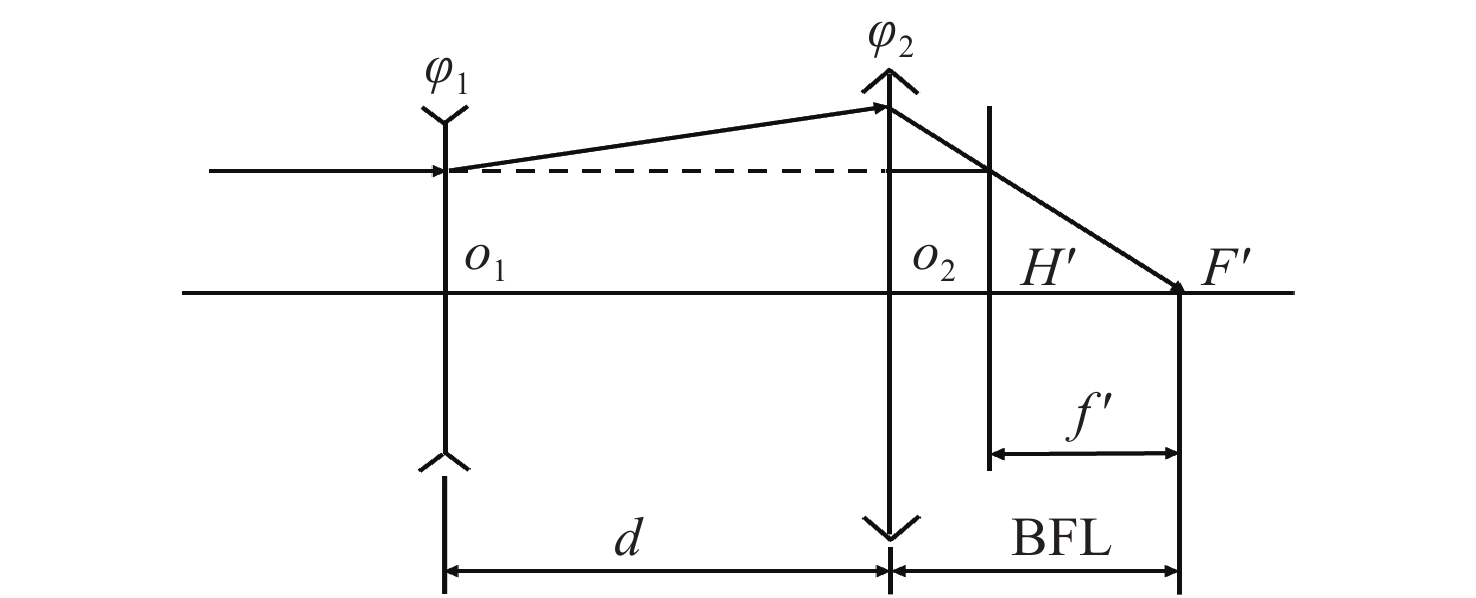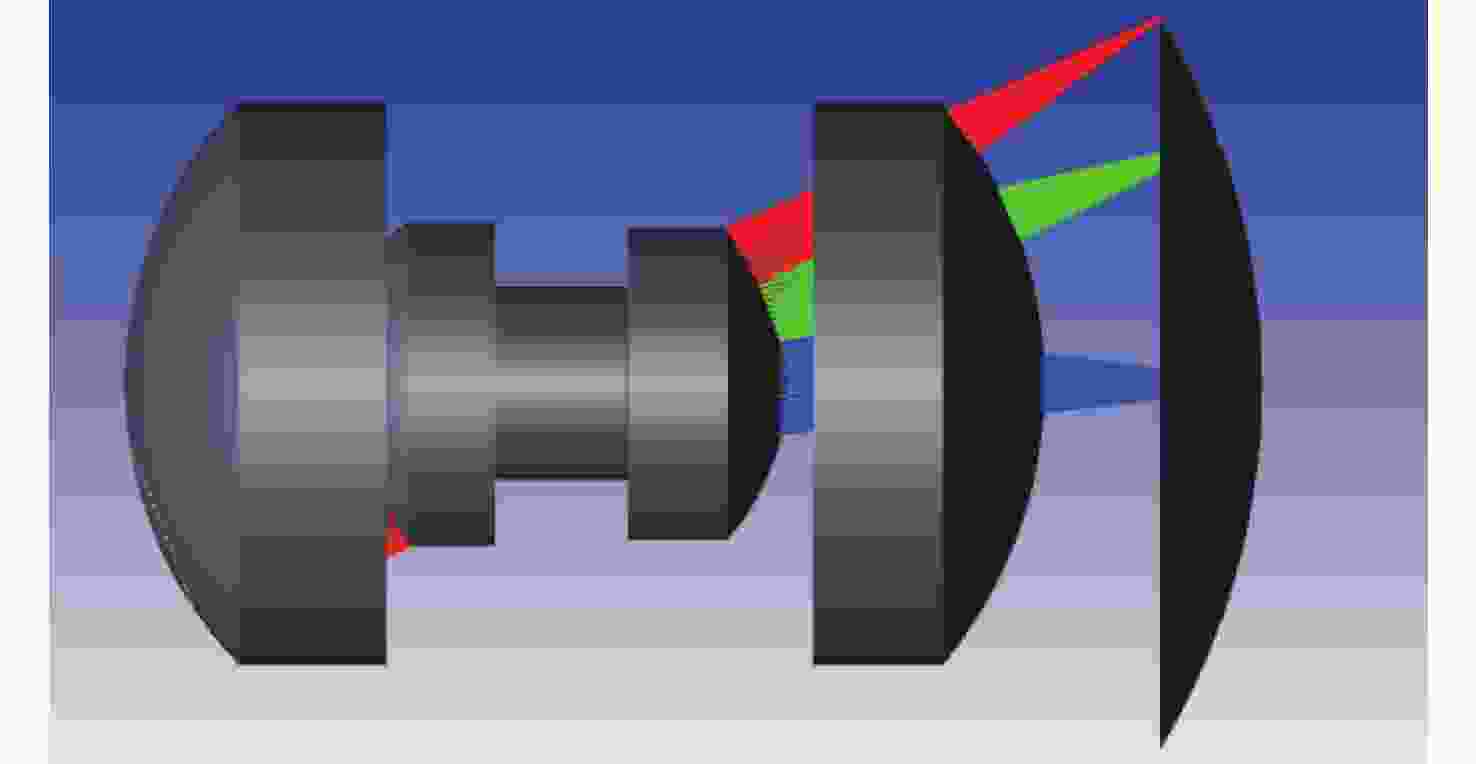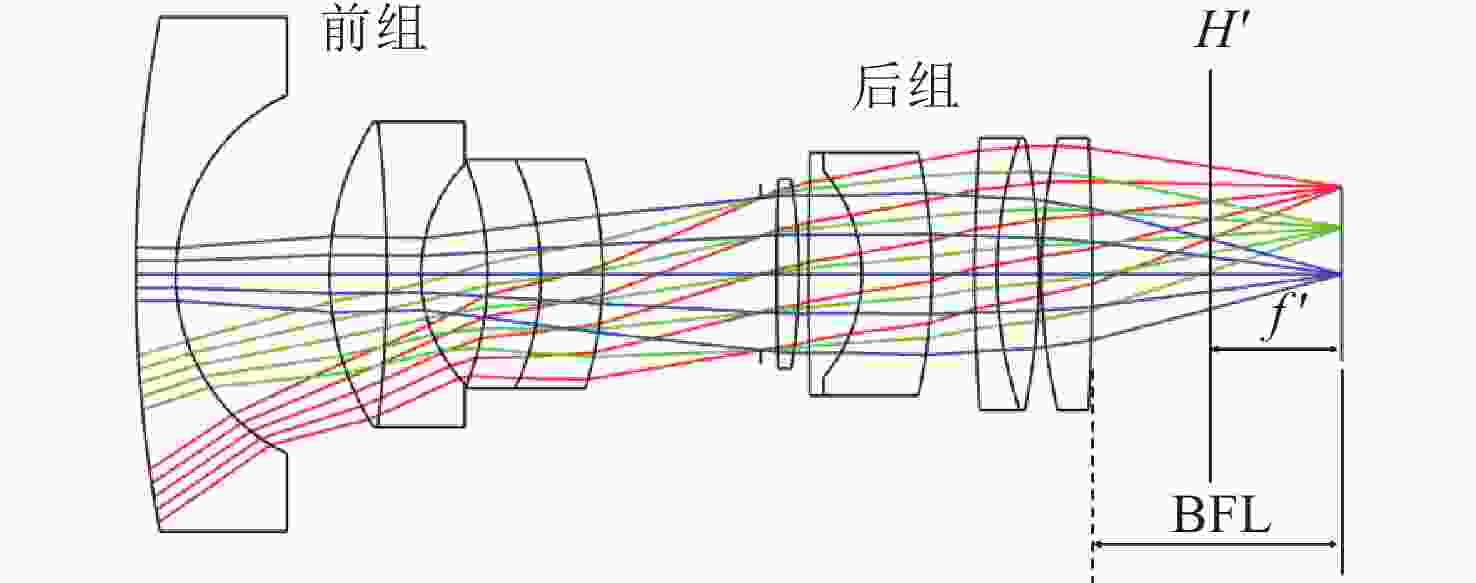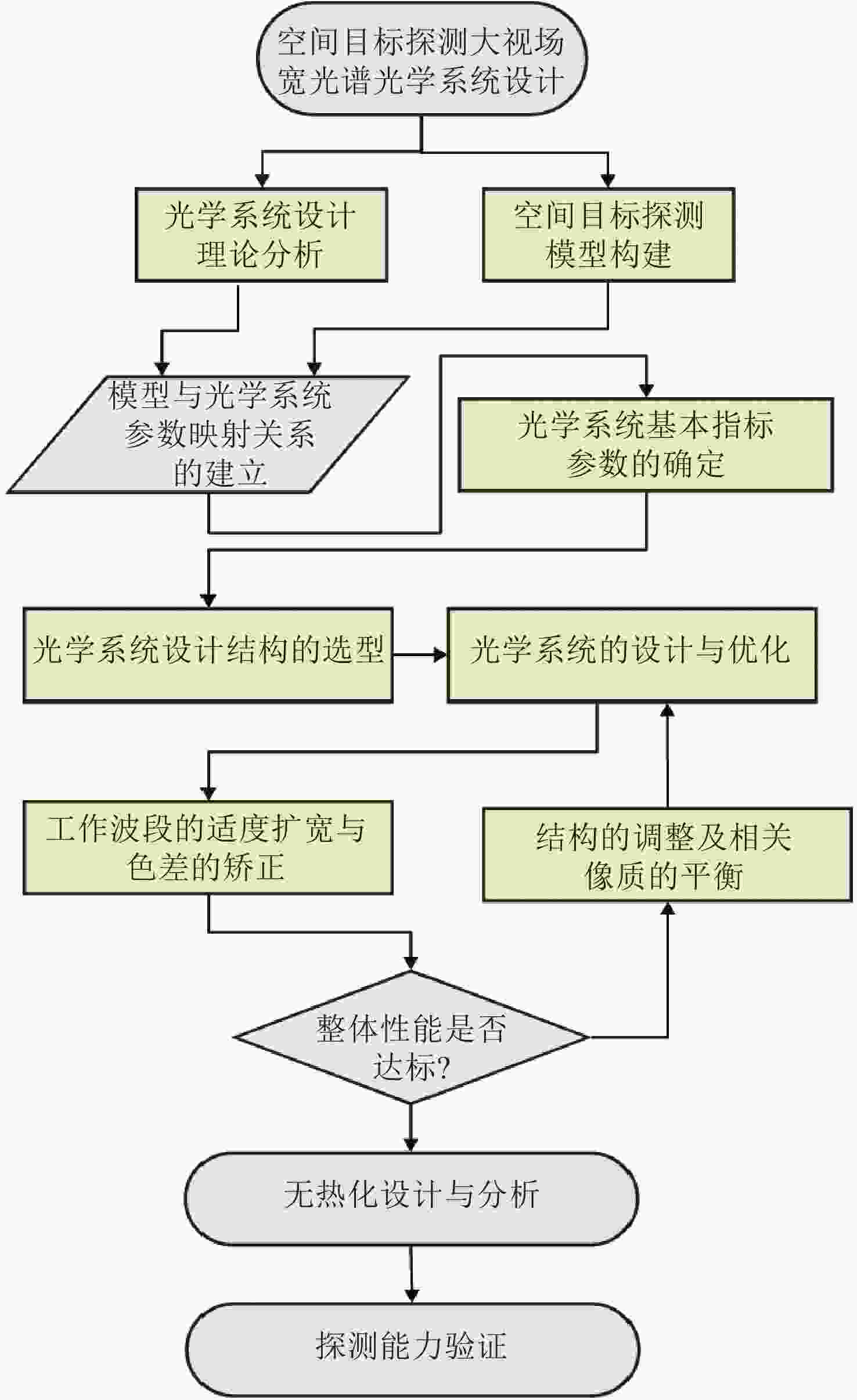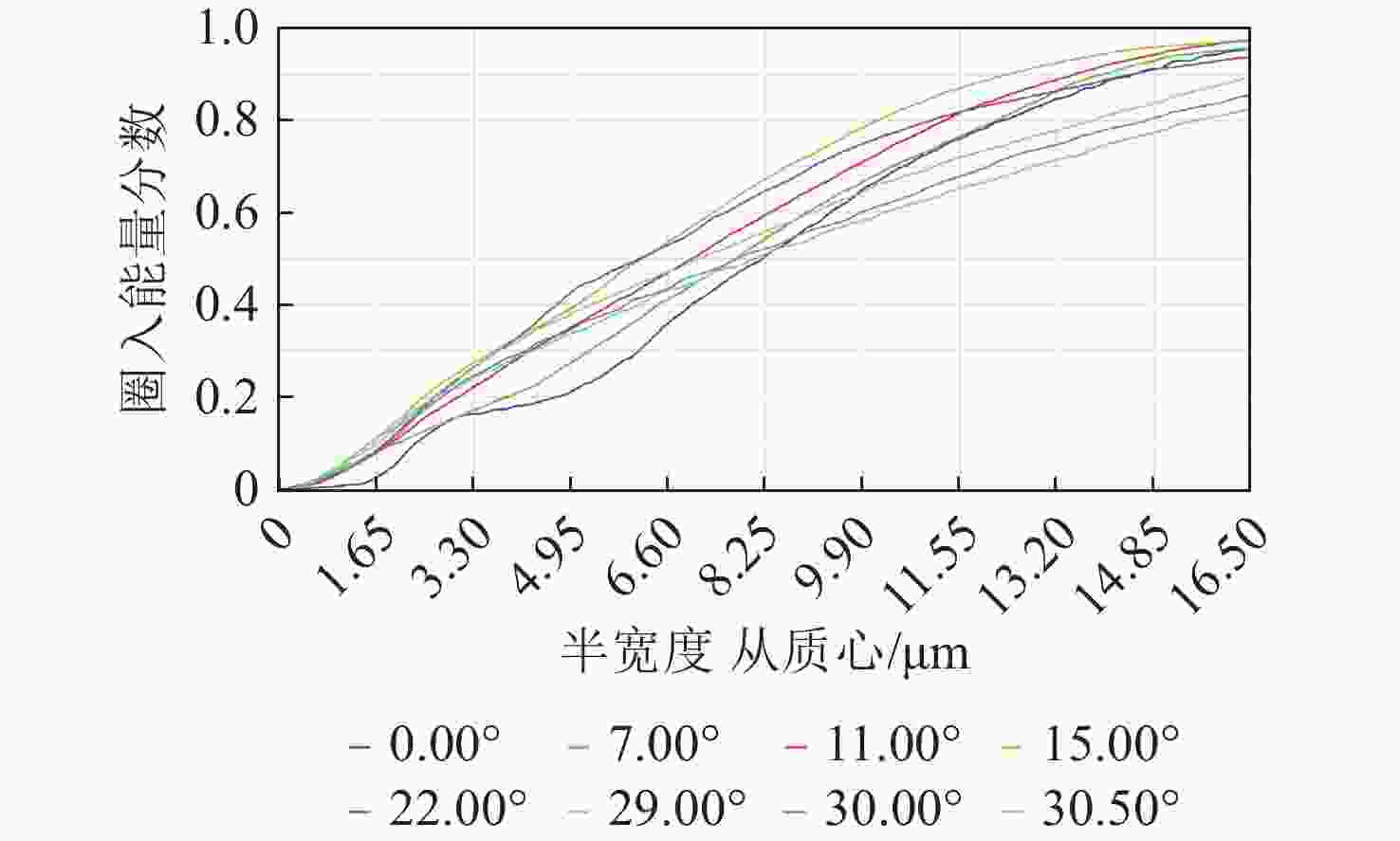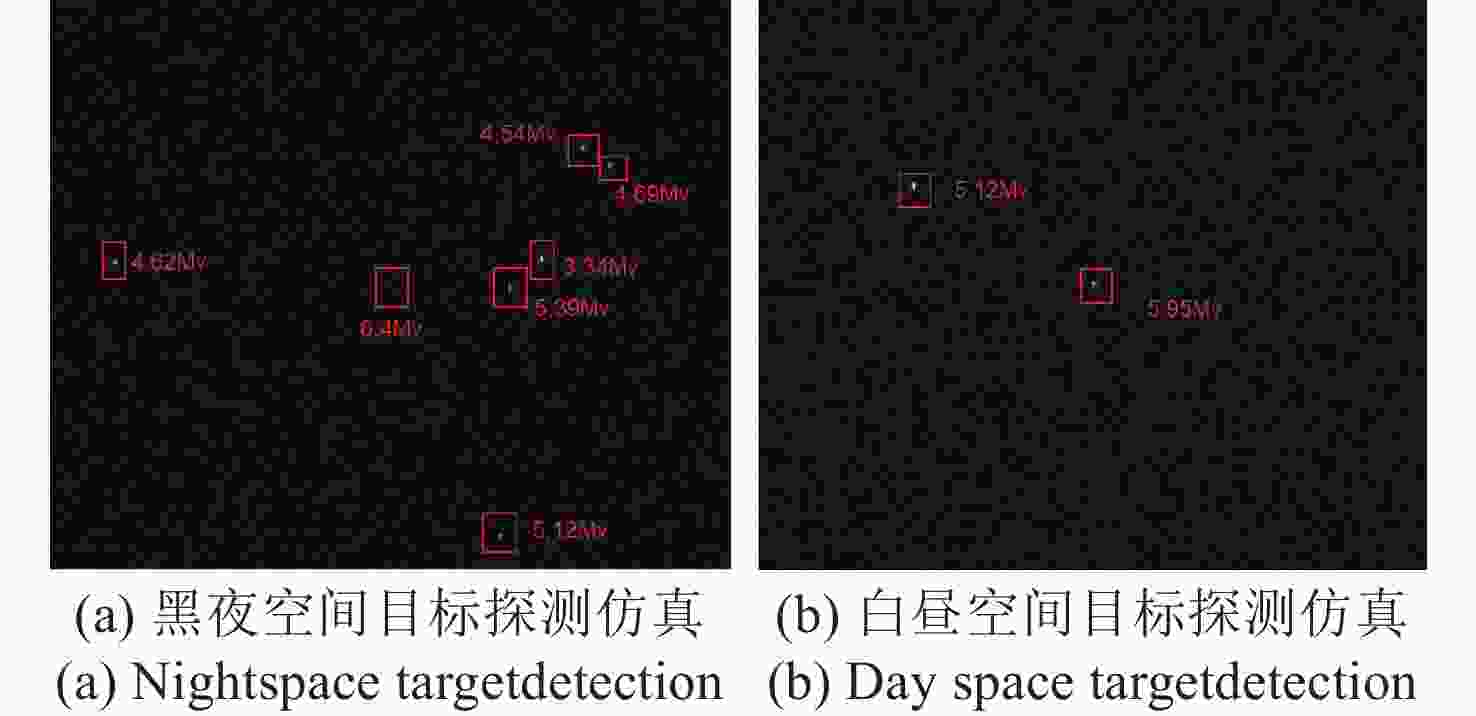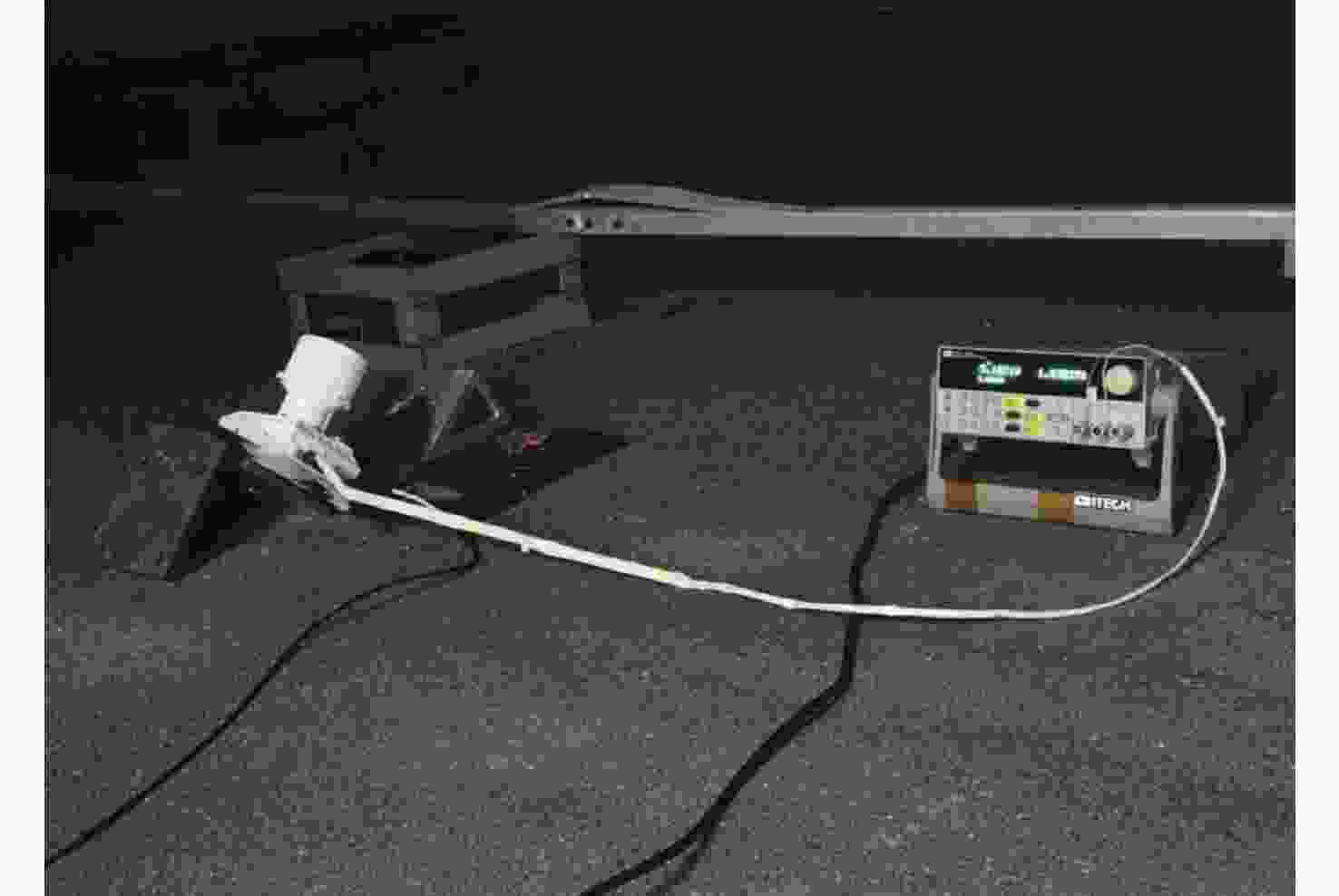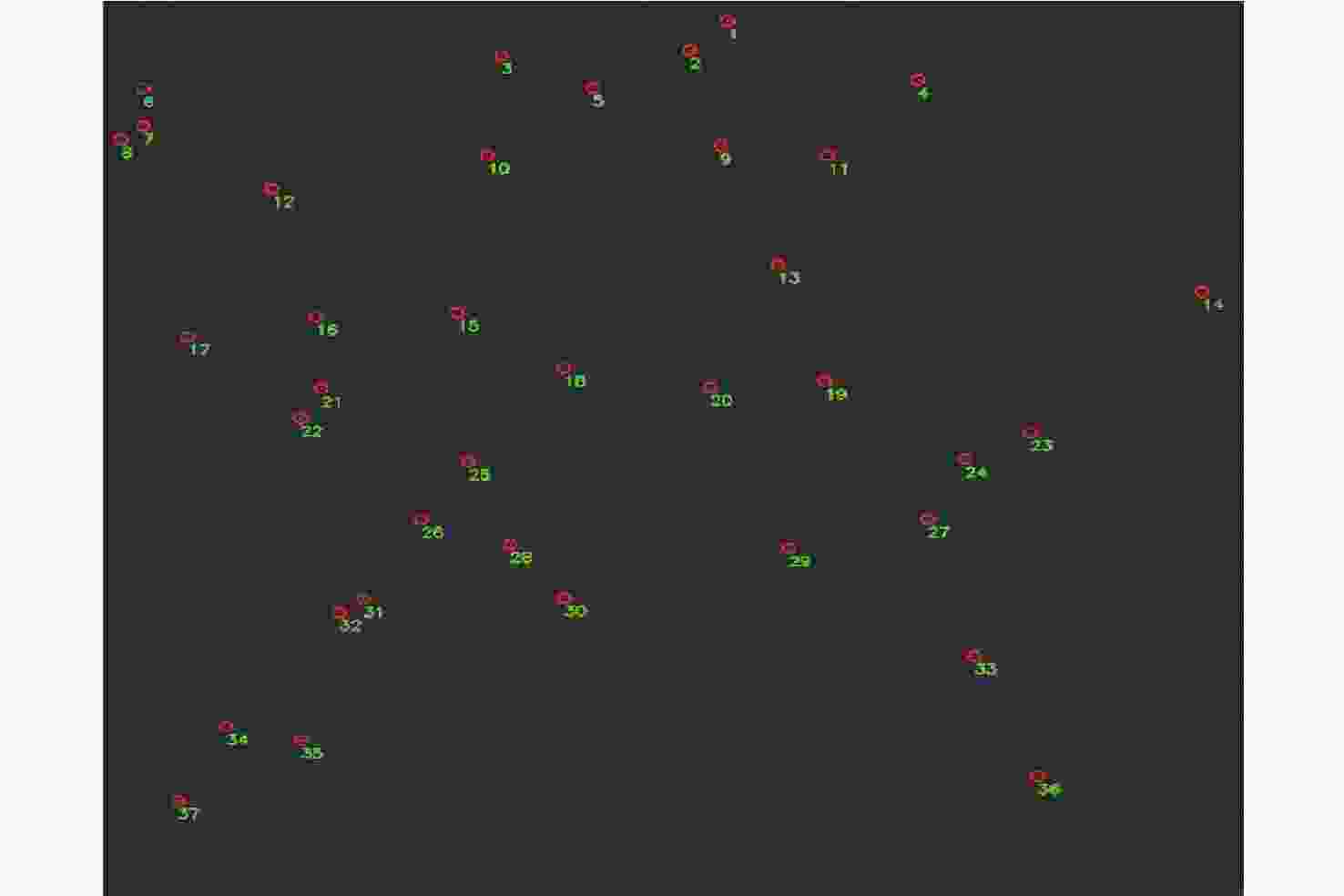Design of optical system with wide field of view, broad spectral range for space target detection
-
摘要:
为了实现空间目标的广域探测,本文设计并研制了一种宽光谱(400 nm−
1000 nm)、大视场(61°)、小F数(1.38)、低畸变的光学系统。该光学系统具备六等星的探测能力,能够实现对空间目标的广域探测。首先,建立空间目标探测辐射特性模型与光学系统参数的映射关系,然后开展相应的光学系统设计理论分析,采用反摄远式结构作为初始的光学系统设计构型。通过优化设计,平衡并校正其大视场与宽光谱带来的严重色差,提高能量集中度的同时兼顾弥散斑圆整度,并通过空间光学仿真进行探测能力验证,其结果表明该光学系统能够满足六等星的空间目标广域探测需求。最后,对该光学系统进行实物探测能力实验验证。实验结果表明,该光学系统具备六等星的空间目标广域探测能力。该光学系统整体设计合理、结构紧凑,能够满足空间目标广域探测的应用需求。Abstract:To achieve wide-area detection of space targets, this study designs an optical system design with a broad spectrum range (400 nm−
1000 nm), a large field of view (61°), a small F-number (1.38), and low distortion. This optical system is capable of detecting space targets with a magnitude of 6, enabling wide-area detection. Initially, a mapping between the radiation model of space target detection and the optical system parameters is established. The optical design is then theoretically analyzed using a reverse telephoto layout as the starting point. The design is optimized to balance and correct severe chromatic aberration resulting from the large field of view and wide spectral range, while improving enclosed energy and considering the roundness of scattered spots. The detection capability is verified through space optical simulation experiments. Results show that the optical system meets the wide-area detection requirements for space targets with a magnitude of 6. Finally, the physical detection capability of the optical system is experimentally verified. The results indicate that the optical system is capable of wide-area detection of space targets with a magnitude of 6. The overall design of the optical system is reasonable and compact, meeting the requirements of wide-area detection of space targets.-
Key words:
- space target /
- wide-area detection /
- optical system design /
- large field of view /
- broad spectrum
-
表 1 光学系统设计参数
Table 1. Optical system design parameters
视场/° 61 工作波段/nm 400- 1000 焦距/mm 27 F数 1.38 3×3像元能量集中度 >80% 探测器靶面尺寸/mm 22.5×22.5 探测器像元尺寸/μm 11 倍率色差/μm <8 温度范围/°C 10-30 相对畸变 <4% 边缘视场照度 >40% 表 2 光学系统类型对比分析
Table 2. Comparative analysis of optical system types
光学系
统类型优点 缺点 反摄
远式1.易于实现轻量小型化。
2.光学系统响应在时间
和空间上具有实时性。1.大视场、宽光谱的情况
下,色差矫正难度大。
2.光学系统设计难度大。同心
物镜式1.所有表面严格共心,不存在
轴外像差,成像质量优异。
2.适合大视场、宽光谱的
光学系统设计。1.像面为曲面,
解决方法繁琐复杂。里斯利
棱镜
扫描式1.该系统可以协同控制算法,
对视场内的某一空间
目标进行动态追踪。
2.可以实现对视场内的
空间目标进行主动规避。1.体积较大,存在因棱镜
引起的色差与畸变[16]问题。
2.系统响应在时间上
有所牺牲。
3.杂散光问题较为严重。表 3 光学系统设计结果
Table 3. Optical system design result
全视场/° 61 工作波段/nm 400- 1000 3×3像元能量集中度 >80% 倍率色差/μm <8 边缘视场照度 >40% 相对畸变 <4% 表 4 温度改变系统焦距相对变化值
Table 4. Relative change in focal length of the temperature changing system
温度/ °C 10 15 20 25 30 焦距/mm 26.966 26.983 27 27.017 27.035 变化/μm −34 −17 0 17 35 表 5 温度改变质心相对变化值(单位:μm)
Table 5. Relative change in centroid due to temperature change
归一化
视场/W温度/ °C 10 15 20 25 30 0 0 0 0 0 0 0.3 −0.341 −0.171 0 0.173 0.347 0.5 −0.581 −0.292 0 0.294 0.591 0.7 −0.851 −0.427 0 0.430 0.865 1 −10.553 −5.300 0 5.347 10.742 表 6 公差分配表
Table 6. Tolerance allocation table
光圈 厚度
/mm镜面偏心
/°镜面倾斜
/°折射率 元件偏心
/°元件倾斜
/°2 0.03 0.01 0.013 0.001 0.01 0.013 表 7 公差分析结果
Table 7. Tolerance analysis results
公差分析结果统计 标准点列图(RMS)/μm 3×3像元能量集中度 90% 优于12.13 大于81% 80% 优于10.93 大于87% 50% 优于8.801 大于91% 20% 优于7.18 大于94% 10% 优于6.50 大于97% 表 8 某一特定空间目标不同距离处探测器响应度
Table 8. Detector response at different distances from a specific spatial target
序号 空间目标与
探测器距离/km传感器处辐照度
(w·m−2)等效等星
(Mv)1 596 3.392816e-11 6.40 2 486 4.996750e-11 5.95 3 376 8.164583e-11 5.42 4 265 1.603319e-11 4.68 5 89 1.395472e-9 2.33 6 44 5.523866e-9 0.84 7 22 2.192820e-8 −0.66 表 9 探测能力实验验证结果
Table 9. Experimental verification results of detection capability
恒星星号 HIP3747 HIP7804 HIP5066 HIP7499 对应等星/Mv 3 3.9 4.9 6 对应光谱类型 A F G K 探测器积分时间/ms 20 20 30 40 -
[1] 刘科, 何磊. “星链”潜在军事应用能力分析研究[J]. 战术导弹技术,2024(3):148-153.LIU K, HE L. Analysis and research on the potential military application capability of Starlink[J]. Tactical Missile Technology, 2024(3): 148-153. (in Chinese). [2] 张煌, 杜雁芸. “星链”军事化发展及其对全球战略稳定性的影响[J]. 国际安全研究,2023,41(5):29-53,157-158.ZHANG H, DU Y Y. Militarization of Starlink and its impact on global strategic stability[J]. Journal of International Security Studies, 2023, 41(5): 29-53,157-158. (in Chinese). [3] 黎璐玫, 刘伟骏, 俞越. 空间碎片现状与挑战[J]. 中国无线电,2023(8):33-36.LI L M, LIU W J, YU Y. Current situation and challenges of space debris[J]. China Radio, 2023(8): 33-36. (in Chinese). [4] YANG Y ZH, LI Y J, WANG J, et al. Design of detection optical system with large relative aperture[J]. Proceedings of SPIE, 2022, 12315: 1231515. [5] JIAO J C, WANG C, YU Y, et al. Lightweight visible light camera technology for weak space target detection[J]. Proceedings of SPIE, 2023, 12317: 123170I. [6] ZHANG G Y, FAN X W, MA Z X, et al. Optical design of space debris detection system with wide field of view[J]. Proceedings of SPIE, 2020, 11570: 1157004. [7] ZONG Y H, ZHUANG X X, ZHANG T CH, et al. Design of a wide field camera for detecting dim targets[J]. Proceedings of SPIE, 2022, 12065: 1206542. (查阅网上资料, 不确定本条文献标黄作者信息, 请确认) . [8] 闫昊昱, 王虎, 薛要克, 等. 大视场红外星敏感器折反式光学系统设计[J]. 飞控与探测,2022,5(5):12-18.YAN H Y, WANG H, XUE Y K, et al. Design of a catadioptric system for infrared star sensor with wide field of view[J]. Flight Control & Detection, 2022, 5(5): 12-18. (in Chinese). [9] 陈醒. 天基空间目标探测系统的光学设计与杂散光研究[D]. 长春: 中国科学院大学(中国科学院长春光学精密机械与物理研究所), 2018.CHEN X. Optical system design and stray light research of a space-based detection camera[D]. Changchun: University of Chinese Academy of Sciences, 2018. (in Chinese). [10] 宋菲君, 陈笑, 刘畅. 近代光学系统设计概论[M]. 北京: 科学出版社, 2019.SONG F J, CHEN X, LIU CH. Introduction to Modern Optical System Design[M]. Beijing: Science Press, 2019. (in Chinese) (查阅网上资料, 未找到本条文献英文信息, 请确认) . [11] LU Y F, ZHOU Y, HEI M, et al. Theoretical and experimental determination of steering mechanism for Risley prism systems[J]. Applied Optics, 2013, 57(7): 1389-1398. [12] CURATU E O, CHEVRETTE P C, ST-GERMAIN D. Rotating-prism scanning system to equip an NFOV camera lens[J]. Proceedings of SPIE, 1999, 3779: 154-164. doi: 10.1117/12.368205 [13] 贵超. 旋转双棱镜超分辨率宽视场成像技术研究[D]. 绵阳: 西南科技大学, 2023.GUI CH. Rotating biprism super-resolution wide field of view imaging technology research[D]. Mianyang: Southwest University of Science and Technology, 2023. (in Chinese). [14] 杨柠宇. 消色差旋转双光楔系统光学设计与研究[D]. 呼和浩特: 内蒙古大学, 2023.YANG N Y. Optical design and study of achromatic rotating dual-wedge prism system[D]. Hohhot: Inner Mongolia University, 2023. (in Chinese). [15] 周远, 鲁亚飞, 黑沫, 等. 旋转双棱镜光束指向解析解[J]. 光学精密工程,2013,21(6):1373-1379. doi: 10.3788/OPE.20132106.1373ZHOU Y, LU Y F, HEI M, et al. Analytic solution of optical beam steering based on rotational double prisms[J]. Optics and Precision Engineering, 2013, 21(6): 1373-1379. (in Chinese). doi: 10.3788/OPE.20132106.1373 [16] 周远, 范世珣, 刘光灿, 等. 旋转双棱镜引起的成像畸变及其校正[J]. 光学学报,2015,35(9):0911003. doi: 10.3788/AOS201535.0911003ZHOU Y, FAN SH X, LIU G C, et al. Image distortions caused by rotational double prisms and their correction[J]. Acta Optica Sinica, 2015, 35(9): 0911003. (in Chinese). doi: 10.3788/AOS201535.0911003 [17] 曾晨欣, 李加慧, 谭奋利, 等. 超轻小宽视场高分辨无人机机载相机光学系统设计[J]. 金宝搏188软件怎么用 与光电子学进展,2023,60(5):0522004.ZENG CH X, LI J H, TAN F L, et al. Optical design of an airborne light weight camera with wide field of view and high resolution[J]. Laser & Optoelectronics Progress, 2023, 60(5): 0522004. (in Chinese). [18] 顾志远, 颜昌翔, 张军强, 等. 基于同心物镜结构的超大视场高分辨率空间目标监视望远镜[C]. 第二届空间目标与碎片监测、清理技术及应用学术研讨会论文集, 中国工程院信息与电子工程学部, 国家自然科学基金委员会, 中国光学工程学会, 2015.GU ZH Y, YAN CH X, ZHANG J Q, et al. Space surveillance telescope with large field of view and high resolution based on monocentric lens[C]. 2015. (in Chinese) (查阅网上资料, 未找到本条文献母体文献和出版者英文信息, 请确认) . [19] SON H S, MARKS D L, HAHN J, et al. Design of a spherical focal surface using close-packed relay optics[J]. Optics Express, 2011, 19(17): 16132-16138. doi: 10.1364/OE.19.016132 [20] SON H S, MARKS D L, HAHN J, et al. Design of a spherical focal surface using close-packed relay optics: erratum[J]. Optics Express, 2013, 21(22): 27284-27285. doi: 10.1364/OE.21.027284 [21] 李闻先. 基于光纤传像元件的空间目标探测系统成像技术研究[D]. 长春: 中国科学院大学(中国科学院长春光学精密机械与物理研究所), 2022.LI W X. Research on imaging technology of space target detection system based on relay image transmission of fiber optic transmission components[D]. Changchun: University of Chinese Academy of Sciences, 2022. (in Chinese). [22] 黄亚伟. 球面光纤束的传像性能研究[D]. 长春: 中国科学院大学(中国科学院长春光学精密机械与物理研究所), 2021.HUANG Y W. Research on image transmission performance of spherical fiber bundle[D]. Changchun: University of Chinese Academy of Sciences, 2021. (in Chinese). [23] 谢丹丹. 天基可见光探测系统指标的优化[D]. 长春: 中国科学院大学(中国科学院长春光学精密机械与物理研究所), 2023.XIE D D. Optimization of the indicators of the space-based visible light detection system[D]. Changchun: University of Chinese Academy of Sciences, 2023. (in Chinese). [24] 朱琳, 吴双, 佟岐, 等. 面向空间探测与识别的目标光学特性分析[J]. 航天电子对抗,2022,38(3):13-16. doi: 10.3969/j.issn.1673-2421.2022.03.004ZHU L, WU SH, TONG Q, et al. Analysis of target optical characteristics for space detection and recognition[J]. Aerospace Electronic Warfare, 2022, 38(3): 13-16. (in Chinese). doi: 10.3969/j.issn.1673-2421.2022.03.004 -






 下载:
下载:


